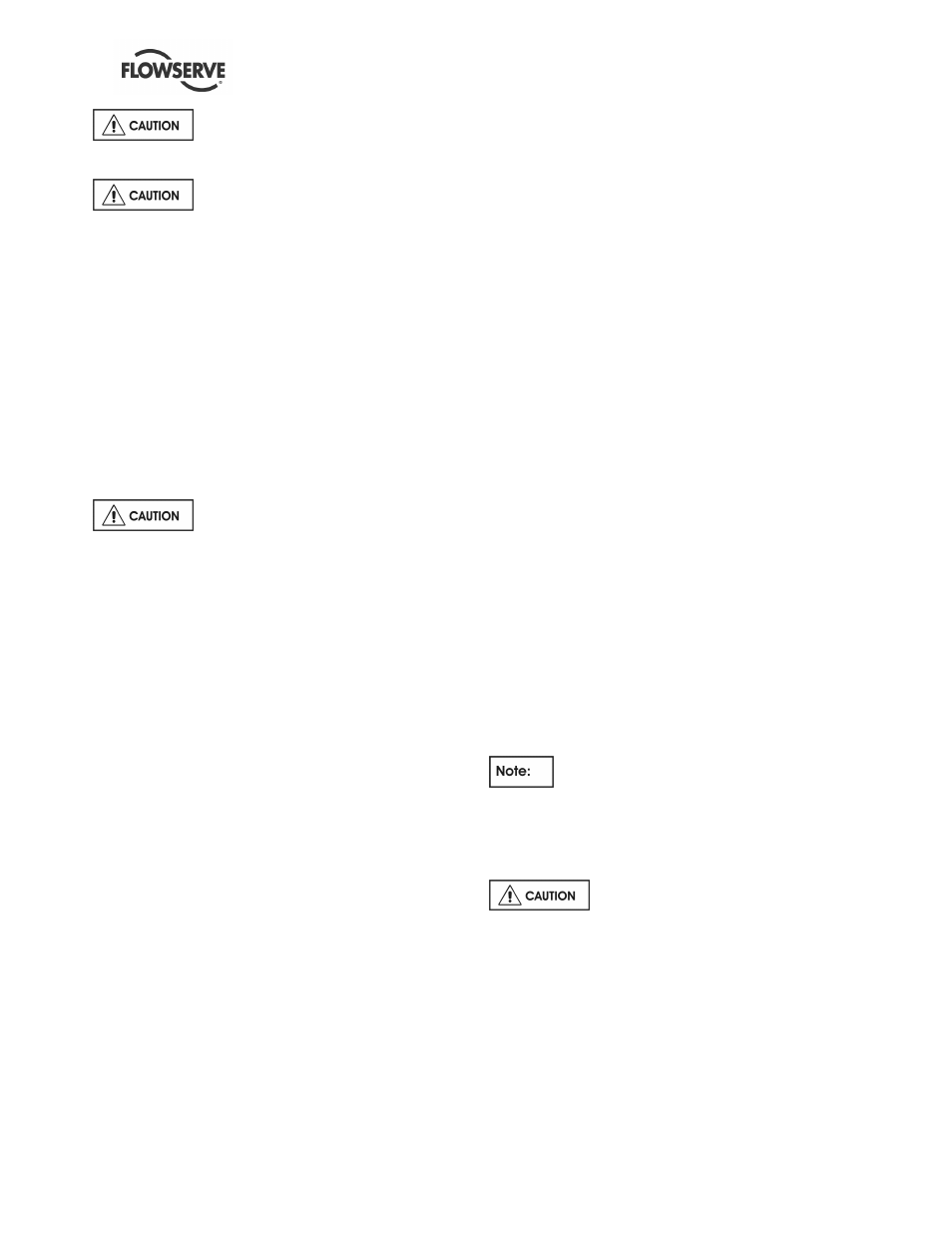Flowserve DMX User Manual
Page 13

DMX/DMXD/DMXH/DMXDH USER INSTRUCTIONS ENGLISH 85392728 - 10/09
Page 13 of 60
Make sure bearings have adequate
lubrication before turning rotor.
The oil inlet blanking plates should be
removed and a small amount of oil injected into the
bearings before turning. Refit blanking plates.
h) Periodically remove bearing covers and inspect
for accumulation of moisture, rust and foreign
material. As required, clean bearings and bearing
housing and re-preserve. Install bearing cover
and secure to assure maximum protection.
Bearings removed for storage should be coated
with preservative, wrapped in oil/wax paper, and
stored in a warm dry area.
i)
Check individually wrapped parts for signs of
deterioration. If necessary, renew preservative
and wrapping.
If storage is over one month,
Instrumentation (Controls, Electrical devices,
Temperature switches) should be removed and
placed in a climate control environment if
Instrumentation is not powered up.
2.4.3.3
Prior to installation maintenance
Six months prior to the scheduled installation date, a
Flowserve representative is to be employed to
conduct an inspection. All costs involved during
inspection, dismantling, restoration, replacement of
parts, and reassembly will be the responsibility of the
customer. The customer will supply all necessary
labor, tools, and cranes. This inspection will include
(not necessarily in its entirety) but not be limited to
the following:
a) An inspection of all periodic inspection records as
kept on file by the customer, and all inspection
reports that have been compiled during the
storage period.
b) An inspection of the storage area to determine
the “as stored” condition of the equipment prior to
any protection being removed.
c) An inspection of the equipment with protection
covers and flange covers removed.
d) Depending upon the length of time the equipment
was stored, the class/type of storage provided,
(i.e.: indoor, heated, unheated, ground floor,
concrete floor, out-of-doors, under roof, no roof,
waterproof coverings, on concrete, on ground)
and as a result of the inspection of a, b and c
above, Flowserve representative may require a
partial or complete dismantling of the equipment.
e) Dismantling may necessitate restoration of
painted or preserved surfaces, and/or
replacement of gaskets, “O” rings and
mechanical seal and bearings. Use only
Flowserve recommended replacement materials.
Upon completion of the inspection, the Flowserve
representative shall submit a report to the Customer,
and to the Manager of Customer Service, stating in
detail the result of the inspection.
If there are any discrepancies identified, it is the
customer's responsibility for correction before initial
startup.
2.4.4
Storage non-preferred (wet)
It is not recommended that the rotor be subjected to
extended periods of submergence or wetting prior to
start-up. However, it is recognized that in some
cases, a long period of time may lapse from
installation until commercial operation.
If the pump must be stored after being installed and
wetted, the following inspection and maintenance
should be performed.
•
Isolate the pump with valving - tag (seal) all
valves.
•
Preserve the pump internals.
If storage is over one month,
Instrumentation (Controls, Electrical devices,
Temperature switches) should be removed and
placed in a climate controlled environment if
Instrumentation is not powered up.
Electric motors (pump driver) should
not be stored in damp places without special
protection (refer to motor manufacturer’s
instructions).
2.4.4.1
Corrosive pumpage.
Fill entirely the pump with an approved preservative
such as #2004-Chempagard 9 from Chempak. The
pump should be filled to highest level possible,
affording the greatest protection possible to all
internal parts of the pump.
